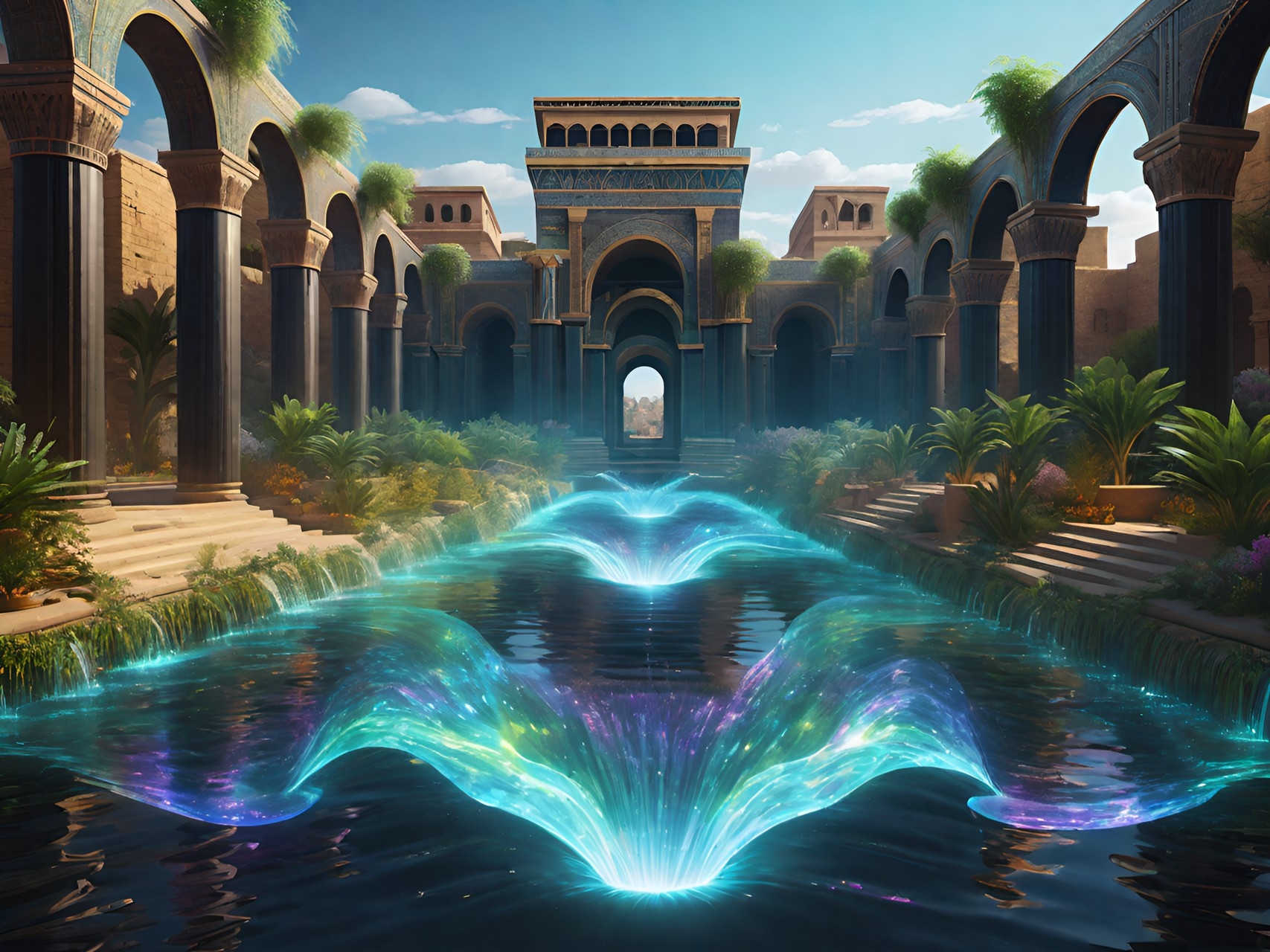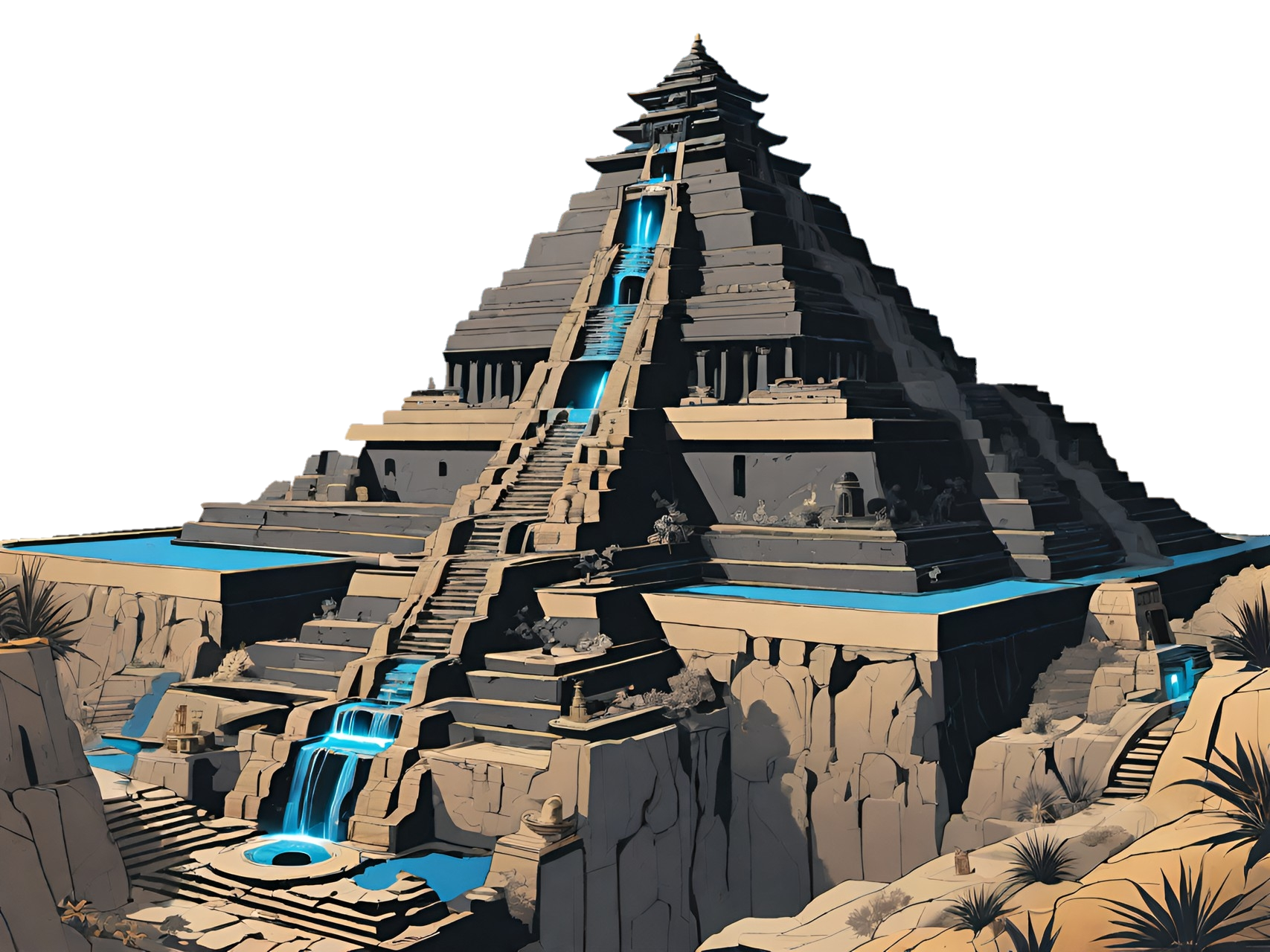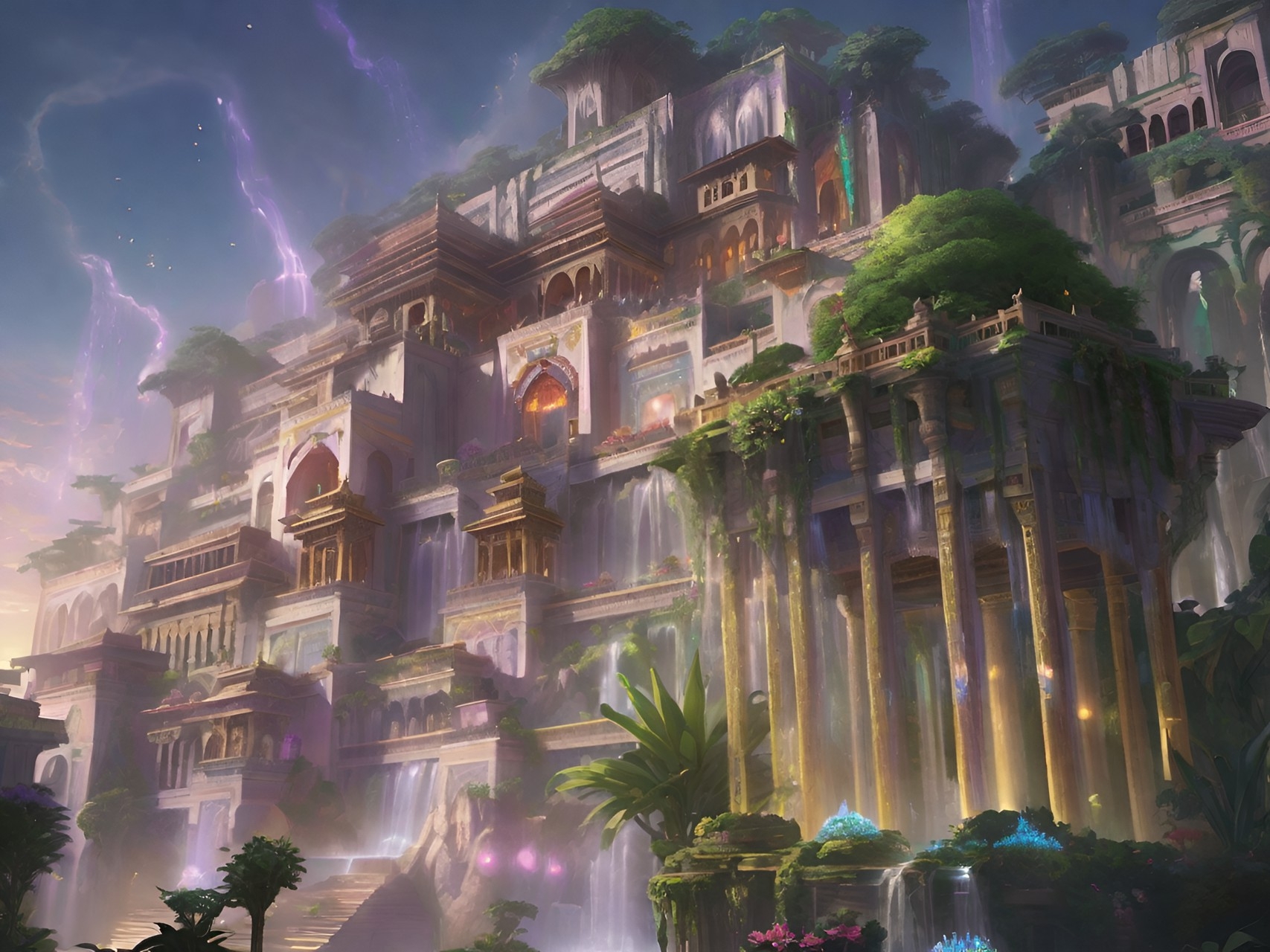Dawn Ahrayn
The Arabiyy call this city al-Daw' al-Nahray meaning "Rivers of the Light" while foreigners have come to call it Dawn Ahrayn as the city rises into the sky with dawn and lowers with sunset. This rise and descent is visible even from Kemet further south. Its true name, Zalidim, is known to very few. This city lays within the surprisingly fertile region of Birit Narim between the Shamsi Desert, al-Arabiyyah, Kemet and Parsa. Radiant light descend from the ziggurat Etemenenki, merging with the headwaters of three rivers below, prismatic and mist-like as it cascades from Lithmor's Seat atop the structure. Zalidim was once a hub for human civilization in Alkelbulan, thanks to both its fertility and because its home to Lithmor's Seat. Lithmor is worshipped as a goddess across Alkelbulan and as an angel or messenger of Luxis within Islam al'Rasul. Zalidim is an important destination for her followers, people treking from across the continent to the nearest city, Babilim, for the briefest glimpse of the city which houses their goddess. They pray for her revival and leave offerings outside its gates, even if they cannot enter Dawn Ahrayn itself and even though she was sealed away tens of thousands of years ago.
Lithmor's Seat is the heart of Zalidim, built into a central ziggurat and home to expansive gardens. Babilim lies below, its name meaning Gate of the Gods, further downstream and bisected by the Purattu River. Zalidim itself is built onto a mystical platform which rises and falls with the sun, resting in a mountaintop crater of Mount Araratat at night and rising to its highest point in the sky at noon. Equally enchanting rivers of light spill from the city in three separate directions, emptying into the rivers al-Nil, Idiqlat and Purattu. Everything these radiant waters touch springs with verdant plantlife, enriching them with raw solar energy. However, too much of this light can cause burns and radiation sickness to those without elemental protection. This, along with those guarding Lithmor's holy city, keeps unwanted visitors from entering Zalidim.
Lithmor's Seat is the heart of Zalidim, built into a central ziggurat and home to expansive gardens. Babilim lies below, its name meaning Gate of the Gods, further downstream and bisected by the Purattu River. Zalidim itself is built onto a mystical platform which rises and falls with the sun, resting in a mountaintop crater of Mount Araratat at night and rising to its highest point in the sky at noon. Equally enchanting rivers of light spill from the city in three separate directions, emptying into the rivers al-Nil, Idiqlat and Purattu. Everything these radiant waters touch springs with verdant plantlife, enriching them with raw solar energy. However, too much of this light can cause burns and radiation sickness to those without elemental protection. This, along with those guarding Lithmor's holy city, keeps unwanted visitors from entering Zalidim.
Founding Date
3,763,426 DE
Also Known As
al-Daw' al-Nahray, Zalidim
Ruling Organization
History
See History of Birit Narim (timeline) or Birit Narim (location)
"I had them shape mud bricks without number and mould-baked bricks like countless raindrops. I had the River Arahtu bear asphalt and bitumen like a mighty flood. Through the sagacity of Ea (Wylrith), through the intelligence of Marduk (Zalikar), through the wisdom of Nabu (Kanilwyr) and Nissaba (Fliral), I commissioned the wisest experts. The master-builders drew taut the measuring cords, they determined the limits. In its foundations I laid out gold, silver, gemstones from mountain and sea. Under the brickwork, I set heaps of shining sapsu, sweet-scented oil, aromatics and red earth. I bowed my neck to my lord Marduk. I rolled up my garment, my kingly robe, and carried on my head bricks and earth. I constructed the building in joy and jubilation and raised its top as high as a mountain. For my lady Shamash (Lithmor), I made it an object fitting for wonder."
The ziggurat which acts as Lithmor's Seat was ancient already, constructed of mud brick and heavily delapidated after it was abandoned. Lithmor was not maintaining it as her Seat either, living instead in Accia with her husband. Yet King Hammurapi was determined to reestablish the Akkadi Empire and regain their goddess' favor. He recreated Enkur, the original temple, in Babilim and created a new temple for each of the gods, giving special attention to Lithmor's temple at the peak. Lithmor, forever optimistic of the nature of mankind, was moved by the olive branch Hammurapi presented, this king known for his diplomatic skills. She solidified her favor for Babilim by creating the Code of Hammurapi, a set of laws which she believed would repair the chaotic era Birit Narim found itself in and prevent the same betrayal she faced from occuring again—to prevent the powerful from abusing the weak. Over the following centuries, Babilim kings of various dynasties continued to improve both Etemenanki and Babilim which Lithmor restablished as her Seat, her radiant waters flowing out into Birit Narim once more and nourishing the land.
King Nabuaplausur in particular expanded Etemenanki. The ziggurat is constructed with seven stages and topped with Lithmor's Seat. The first stage is the tallest, each sequentially shorter, and a paired flight of stairs is located centrally. The temple itself has buttressed outer walls and a series of inner chambers before reaching the headwaters, Lithmor's Seat. Gardens overflow from these different platforms, even home to a vertiable forest of rare trees and flowers bursting with fruit and greenery. They did so without physical aid from the gods, Lithmor exuberant to see what her followers were capable of with only the aid of knowledge. That isn't to say only Lithmor offered them this knowledge, Wylrith, Fliral and even Zalikar offering them advice. It wasn't until construction finished that Lithmor began weaving light magic into the brickwork, a secondary, illusiary palace of prismatic lights hovering atop her Seat. Prismatic illusions laced the entire city, beautifying it and adding the dash of color Lithmor is so fond of.
King Nabuaplausur in particular expanded Etemenanki. The ziggurat is constructed with seven stages and topped with Lithmor's Seat. The first stage is the tallest, each sequentially shorter, and a paired flight of stairs is located centrally. The temple itself has buttressed outer walls and a series of inner chambers before reaching the headwaters, Lithmor's Seat. Gardens overflow from these different platforms, even home to a vertiable forest of rare trees and flowers bursting with fruit and greenery. They did so without physical aid from the gods, Lithmor exuberant to see what her followers were capable of with only the aid of knowledge. That isn't to say only Lithmor offered them this knowledge, Wylrith, Fliral and even Zalikar offering them advice. It wasn't until construction finished that Lithmor began weaving light magic into the brickwork, a secondary, illusiary palace of prismatic lights hovering atop her Seat. Prismatic illusions laced the entire city, beautifying it and adding the dash of color Lithmor is so fond of.
Architecture
Most structures in Zaladim were originally built from sun-baked mudbricks reinforced with fiber (straw/plant stalks) and coated with asphalt while foundations were constructed of fired bricks, the entire city following a grid pattern aligned with its rivers of light. Since its initial construction, the city has been home to more advanced architectural improvements carried out by Lithmor's followers or even Erlithmanil allies. While the city of Bibilim has been destroyed and rebuilt many times, Zaladim has remained untouched by the wars of humanity.
There are two roads leading up the peak to the city, one on the north side and another on the south. One stretches from the northern gate, through Babilim and all the way to the banks of Parattu River, where the river of light mixes with Parattu. The north side is particularly steep, al-Nil bound light cascading weightlessly over seeming waterfalls, but allows pilgrims from Kemet to access the city. On the northern road, Kukugal Gate is considered the closest one can get to Dawn Ahrayn, a place for pilgrims to gather and even leave offerings for Lithmor, collected by her guardians. Usually, this gate is obscured by the river of light, only diverting when opening up.A mural of Zalikar as Marduk and a draconic Mushussu can be seen on the right and left of the gate while an image of Lithmor as Shamash waits behind the waterfal.
There are two roads leading up the peak to the city, one on the north side and another on the south. One stretches from the northern gate, through Babilim and all the way to the banks of Parattu River, where the river of light mixes with Parattu. The north side is particularly steep, al-Nil bound light cascading weightlessly over seeming waterfalls, but allows pilgrims from Kemet to access the city. On the northern road, Kukugal Gate is considered the closest one can get to Dawn Ahrayn, a place for pilgrims to gather and even leave offerings for Lithmor, collected by her guardians. Usually, this gate is obscured by the river of light, only diverting when opening up.A mural of Zalikar as Marduk and a draconic Mushussu can be seen on the right and left of the gate while an image of Lithmor as Shamash waits behind the waterfal.
Defenses
After the sacking of her previous temple, Zalikar insisted her Seat be better guarded. He oversaw the construction of two massive walls at the base of her sacred mountain, Mount Ararat of the Urartu Mountains, and two fortresses within Zalidim itself. One fortress is home to a royal palace and the second is barracks for her chosen guardians, each taking up 40 acres and well fortified. The palace walls run 1,300 ft (402 m) in each direction and enclose the two complexes. Another set of walls and ramparts run for 11 miles at the base of Mount Ararat, encircling the entirety of Zalidim's grounds. The southeast junction is home to irrigated fields and canals set aside for more serious agriculture, mostly of wheat and barley. Lithmor's guardians patrol these ramparts in shifts, keeping eyes out for aerial or terrestrial invasion. There are also protective barriers placed by true magic mages which disallow unwanted aerial access (similarly to Accia).
Seemingly hundreds of gates lay between Babilim and Zaladim as it winds up the mountain but the true danger lays beyond each wall. A mass portal connecting to Rithaldis' Plane pours out solar plasma from the crater of Mount Ararat, resembling a great volcano with searing white lava. Inching its way downhill, this plasma passes through grates and canals as the base of each wall, pooling along each barrier—extremely hot and radioactive. These walls and gates are constructed of tungsten, capable of withstanding the immense heat, before slipping back into smaller solar portals behind the final wall. Far more volatile than the river of light cascading from Etemenanki, the flow of this solar plasma can be diverted by guardians of Zaladim to allow visitors to pass but none have been permitted inside without her express persmission. Lithmor's followers are also capable of manipulating this plasma to defend the city, pulling from the moats as needed.
Seemingly hundreds of gates lay between Babilim and Zaladim as it winds up the mountain but the true danger lays beyond each wall. A mass portal connecting to Rithaldis' Plane pours out solar plasma from the crater of Mount Ararat, resembling a great volcano with searing white lava. Inching its way downhill, this plasma passes through grates and canals as the base of each wall, pooling along each barrier—extremely hot and radioactive. These walls and gates are constructed of tungsten, capable of withstanding the immense heat, before slipping back into smaller solar portals behind the final wall. Far more volatile than the river of light cascading from Etemenanki, the flow of this solar plasma can be diverted by guardians of Zaladim to allow visitors to pass but none have been permitted inside without her express persmission. Lithmor's followers are also capable of manipulating this plasma to defend the city, pulling from the moats as needed.
Landmarks
Kukagal and Tirannagalam
The most impressive gate by far is Kukagal. This is a double gate with one smaller front door and one larger and broader counterpart behind it. Glazed blue with reliefs of bulls and lions, a brick facade embellishes the sides of the gate which reaches 50 ft (15 m) high and 45 ft (14 m) underground. For those lucky enough to ascend the steps to Zaladim, a great processional street which is 60 ft wide runs from gate to gate. The pathyway is lined with prismatic limestone, changing to a different color with each step one takes which is what earned it its name, Tirannagalam meaning "Rainbow Ascent". Living illusions line these stairs, realistic images of 120 lions, bulls, mushussu and flowers lounge, run and watch passerby, moving about a sea of lapis lazuli. These illusions were set down by Lithmor and will even report back to Lithmor or guards of anyone daring to try to infiltrate Zalidim uninvited. When under attack, these illusionary beasts will even leap from their lazuli tapestry and, looking quite real, threaten intruders despite being unable to touch them. But that isn't to say there is no danger. Real mushussu are known to patrol the grounds at night, readily mixing themselves with illusory mushussu!
The walls themselves are topped by cedar wood, made from a partuclar species from Idraren Draren which are immune to damage or catching fire from radiant energy. They impart a delicate aroma to those ascending and are a sacred tree to local populations. Each gate also features a different god or goddess, their likenesses crafted from gold, ivory, ebony and bronze. All materials are sealed together with asphalt, black peeking between each piece. Tirannagalam leads to one final gate, a portal up into the city itself regardless of its current altitude.
The walls themselves are topped by cedar wood, made from a partuclar species from Idraren Draren which are immune to damage or catching fire from radiant energy. They impart a delicate aroma to those ascending and are a sacred tree to local populations. Each gate also features a different god or goddess, their likenesses crafted from gold, ivory, ebony and bronze. All materials are sealed together with asphalt, black peeking between each piece. Tirannagalam leads to one final gate, a portal up into the city itself regardless of its current altitude.
Etemenanki and Anlal Hekiri
Prismatic colors and vibrant plantlife dress this immense ziggurat, misty photons pouring from the peak of Etemenanki all the more brilliant as it cascades from platform to platform. This seeming sea of stardust wells along the base of Etemenanki before flowing out through canals and merging with the rivers further downhill, mixing into their waters. Truly akin to a mountain, Etemenanki stretched to a height of 300 ft (91 m) with a square base of another 300 ft! The temple atop the ziggurat has one entrance facing the dawn and another facing sunset while a number of smaller temples are constructed along the lower levels. The upper temple is a veritable palace, designed for the utmost luxury for their goddess. One needn't even leave the ziggurat to sustain themselves either, its gardens not only fully functional but overflowing with abundance thanks to the careful planning of Fliral herself. This was done by use of water screws to irrigate every level of the ziggurat.
There are gardens not only on the Etemenanki but throughout the grounds of the city, referred to as Anlal Hekiri, "Abundant Garden Hung in the Sky". Grown in tiered platforms, between streets and atop buildings, vaults and arches, trees, vines and shrubs thrive on Lithmor's gentle sunlight. Miniature suns and orbs of light hover over stone pillars to light the streets and aqueducts flow gently, guiding water from hidden springs while water screws lift water into gardens, driven by windmills. The streets are sunbleached white and kept meticulously clean by Lithmor's cultists, according to her laws. There is no shortage of food in Dawn Ahrayn, overflowing with light, fruit, water and overall life. Those chosen inhabitants of Zalidim, blessed with light magic, glide along her rivers of light faster than one can perceive. Even the tiled streets are known to illuminate or change color as one walks across them and all manner of beasts blessed with light magic make their home in Zalidim such as Bennu Phoenix, Paraa Falcon, Masryeen Vulture, al-Nil Crocodile, Solar Moth and Axex.
There are gardens not only on the Etemenanki but throughout the grounds of the city, referred to as Anlal Hekiri, "Abundant Garden Hung in the Sky". Grown in tiered platforms, between streets and atop buildings, vaults and arches, trees, vines and shrubs thrive on Lithmor's gentle sunlight. Miniature suns and orbs of light hover over stone pillars to light the streets and aqueducts flow gently, guiding water from hidden springs while water screws lift water into gardens, driven by windmills. The streets are sunbleached white and kept meticulously clean by Lithmor's cultists, according to her laws. There is no shortage of food in Dawn Ahrayn, overflowing with light, fruit, water and overall life. Those chosen inhabitants of Zalidim, blessed with light magic, glide along her rivers of light faster than one can perceive. Even the tiled streets are known to illuminate or change color as one walks across them and all manner of beasts blessed with light magic make their home in Zalidim such as Bennu Phoenix, Paraa Falcon, Masryeen Vulture, al-Nil Crocodile, Solar Moth and Axex.
Lithmor took the royal palace of Zaladim for herself, keeping her temple grounds purely for religious purposes. This palace has 250 rooms, five courtyards and a hundred foot arch at its entrance. Her palace is home to a colorful, fruitful garden, curling itself about collumns and arches on the roof of her palace. Fruit trees especially are found throughout Dawn Ahrayn, including those producing dates, almonds, juniper berries, olives, walnuts, pomegranates, plums, pears and figs. Other trees were planted for shade, utility or for their beauty, including cypress, pine, willow, rosewood, ebony, Maliha Tamarisk, Isik Sakiz Tree, ash and fir. Comined with colorful murals, vibrant flowers and cascading waterfalls, Lithmor enjoyed hosting guests in this garden while lounging under pagodas, enjoying the calls of songbirds and eating fresh fruit.
Population
The only inhabitants of Zaladim are members of Lithmor's cult, the Zalag Ennun. These women are chosen from across Emynea for their faith, honor, intelligence and fierceness as warriors. Some of these original inhabitants were attendants, others warriors and the rest scholars who had impressed her. Their descendants carry on their duties even is Lithmor was sealed away into her Seat. They guard it still, maintain her temple grounds and continuing to perform ancient rituals in her honor. Because of their rare light magc, Lithmor's followers are among the few still capable of communicating with Lithmor's aspects. New members are occasionally selected by Lithmor, observing humanity through her Elemental Planes. On her command, they journey out into Emynea to recruit new members.
Zalidim has little to no contact with the outside world since the downfall of their goddess. Its inhabitants take care of the grounds and guard her city and temples. There are still many pilgrims who travel to Babilim and leave offerings at Kukagal. Her guardians are known to collect these and either store them in Lithmor's temple or even transfer them into her planes for her aspects to enjoy. On rare occassions, her followers might even descend into the city to trade surplus from their gardens for materials and artisan goods with the town of Babilim or even Masr.
Zalidim has little to no contact with the outside world since the downfall of their goddess. Its inhabitants take care of the grounds and guard her city and temples. There are still many pilgrims who travel to Babilim and leave offerings at Kukagal. Her guardians are known to collect these and either store them in Lithmor's temple or even transfer them into her planes for her aspects to enjoy. On rare occassions, her followers might even descend into the city to trade surplus from their gardens for materials and artisan goods with the town of Babilim or even Masr.
Back when Lithmor still walked Emnea, she opened the gates and halted the plasma flow once a year to celebrate a New Year Festival. Pilgrims were allowed into her city to celebrate, these annual rituals and celebrations lasting twelve days! Occuring near March, the new year was marked by the harvest of barley and the spring equinox. Fliral, Ylithuum, Rylis, Raegeric and sometimes others were also known to attend, accepting offerings and celebrating.











Comments